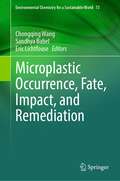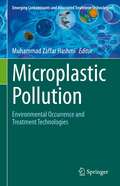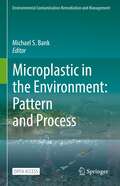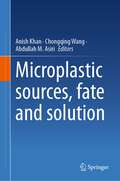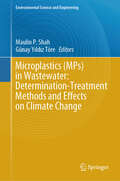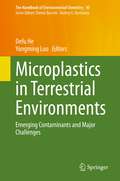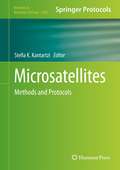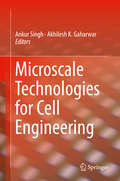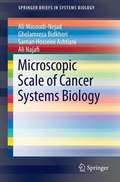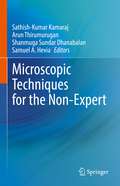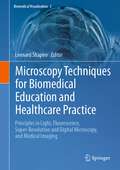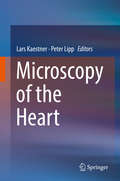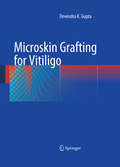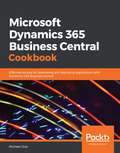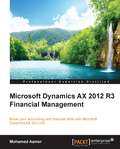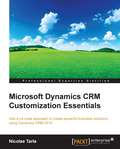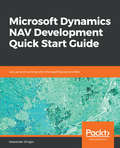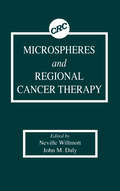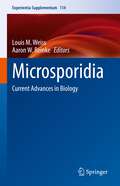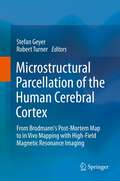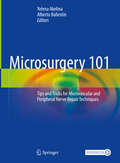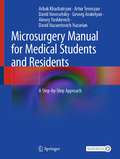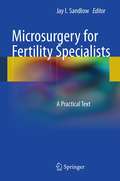- Table View
- List View
Microplastic Occurrence, Fate, Impact, and Remediation (Environmental Chemistry for a Sustainable World #73)
by Eric Lichtfouse Chongqing Wang Sandhya BabelMicroplastics and nanoplastics have been recently found in most environmental media and in living organisms, thus representing a serious health concern of yet poorly known adverse consequences. This book summarizes recent findings on the sources, behavior, transformation, toxicity and remediation of microplastics, with focus on soils, water, wastewater, air, soils, plants and corals. Advanced methods for sampling, characterization, removal and degradation of microplastics.
Microplastic Pollution: Environmental Occurrence and Treatment Technologies (Emerging Contaminants and Associated Treatment Technologies)
by Muhammad Zaffar HashmiThis volume discusses the growing issue of global environmental microplastic pollution resulting from the industrial manufacturing of everyday products. The book focuses on the emergence of microplastic pollution, types, sources, fate, dynamic trends in the environment, occurrence in different environmental settings, toxicity, risk assessment, and prevention strategies. The authors provide a detailed explanation and provision of the techniques used for the detection, separation, and identification of microplastics for use by industry workers and scientists, along with policy recommendations for legislative bodies to reduce the spread and impact of harmful microplastics. The book will be of use to students, teachers, researchers, policy makers, and environmental organizations.
Microplastic in the Environment: Pattern and Process (Environmental Contamination Remediation and Management)
by Michael S. BankThis open access book examines global plastic pollution, an issue that has become a critical societal challenge with implications for environmental and public health. This volume provides a comprehensive, holistic analysis on the plastic cycle and its subsequent effects on biota, food security, and human exposure. Importantly, global environmental change and its associated, systems-level processes, including atmospheric deposition, ecosystem complexity, UV exposure, wind patterns, water stratification, ocean circulation, etc., are all important direct and indirect factors governing the fate, transport and biotic and abiotic processing of plastic particles across ecosystem types. Furthermore, the distribution of plastic in the ocean is not independent of terrestrial ecosystem dynamics, since much of the plastic in marine ecosystems originates from land and should therefore be evaluated in the context of the larger plastic cycle. Changes in species size, distribution, habitat, and food web complexity, due to global environmental change, will likely alter trophic transfer dynamics and the ecological effects of nano- and microplastics. The fate and transport dynamics of plastic particles are influenced by their size, form, shape, polymer type, additives, and overall ecosystem conditions. In addition to the risks that plastics pose to the total environment, the potential impacts on human health and exposure routes, including seafood consumption, and air and drinking water need to be assessed in a comprehensive and quantitative manner. Here I present a holistic and interdisciplinary book volume designed to advance the understanding of plastic cycling in the environment with an emphasis on sources, fate and transport, ecotoxicology, climate change effects, food security, microbiology, sustainability, human exposure and public policy.
Microplastic sources, fate and solution
by Abdullah M. Asiri Anish Khan Chongqing WangThis book provides an overview of the sources, occurrence, fate and solution of microplastics. Microplastics in sediment and soil environment have been only scarcely surveyed, and no profound discussion on microplastics removal is summarized until this book. Here we focus on sharing clear schematic information and the book sufficiently supports important microplastic topics: such as microbial network, microplastic toxicology and accumulation, agricultural plastics, nylon microplastics, polystyrene microplastics, polyethylene microplastics and many more. The book mainly provides an overview of recent advances in knowledge of sources, occurrence, distribution, chemical behavior and ecological threats while it also presents information related to feasible solutions for microplastic pollution management. This comprehensive resource will be valuable up-to-date knowledge for environmental scientists, ecotoxicologists, ecologists, marine biologists, environmental chemists in the academic field and this book is intended to be beneficial information for environmental managers, water suppliers, wastewater treatment, plastics manufacturer, and policy makers as well.
Microplastics (Environmental Science and Engineering)
by Maulin P. Shah Günay Yıldız TöreThis book systematically summarizes the occurrence and source of MPs through various municipal and industrial wastewaters. It covers the type of MPs, its effects on human health and climate, and emerging detection and treatment methods. Plastics are one of the refractory pollutants produced in many and varied forms using chemistry and materials science. Microplastics (MPs), which are formed as a result of plastics breaking down into small pieces, are a new indicator that indicates that the plastic footprint of humans is growing today and this has become a risk for the general living health and sustainable environment. Depending on the point of use, they are either directly released to the air, water, and soil, or they break down into secondary MPs in the environment where they are discharged. Especially by means of domestic wastewater, plenty of MPs enter the sewage system on a daily basis. Therefore, wastewater treatment plants (WWTPs) draw attention as an important source of MP pollution in coastal or surface waters such as sea, lake, and river. There is still a limited number of studies on MPs in the literature and it has become the focus of many researchers around the world. This book mainly focuses on the behavior of microplastics in the wastewaters. The book has 12 chapters and throughout each chapter, it presents the fate and effect of MPs, quantitative and qualitative analyses of MPs in wastewaters and treatment of MPs through conventional and advanced wastewater treatment technologies, effects of MPs on human health and climate change and also evaluates the legal restrictions for MPs pollution in the environment and will also be examined in all details. It also boosts the knowledge of students, researchers, scientists, professors, engineer, and professionals who aspire to work in the field of environmental science, environmental biotechnology, environmental microbiology, civil/environmental engineering, eco-toxicology and other relevant areas of wastewater treatment and management for the safety of environment. In addition to this, the readers of the book can also get the valuable information about the various environmental problems-related climate change and their solutions.
Microplastics in Terrestrial Environments: Emerging Contaminants and Major Challenges (The Handbook of Environmental Chemistry #95)
by Yongming Luo Defu HeThis book focuses on microplastics as emerging persistent contaminants in terrestrial environments. Scientists from around the globe review recent advances in multi-disciplinary research on micro(nano)plastics, including analytical methods; the sources, fate and distribution of microplastics; ecological risks; toxicity and health risks; and control and countermeasures for microplastics in terrestrial environments. Offering a comprehensive overview of microplastics in terrestrial environments, the book is a valuable resource for environmental researchers, ecologists and toxicologists, as well as for policymakers and non-experts.
Microsatellites
by Stella K. KantartziMicrosatellites or simple sequence repeats (SSRs) have become the markers of choice for a variety of molecular studies because of their versatility, operational flexibility, and lower cost than other marker systems. Microsatellites: Methods and Protocols brings together experts in the field to cover this significant area of research. Broken in to four convenient parts, this volume delves into classical and modern methods for the discovery and development of microsatellite markers, descriptions of amplification and visualization of SSRs, automated capillary sequencers that are widely used for fragment analysis, as well as a variety of methods for the analysis of data obtained by the use of microsatellites. Written for the highly successful Methods in Molecular BiologyTM series, chapters include introductions to their respective topics, lists of the necessary materials and reagents, step-by-step, readily reproducible laboratory protocols, and tips on troubleshooting and avoiding known pitfalls. Authoritative and invaluable, Microsatellites: Methods and Protocols aims at researchers that need detailed protocols for incorporating microsatellite markers into their projects and expert scientists looking to expand their knowledge of SSRs discovery, use, and analysis.
Microscale Technologies for Cell Engineering
by Ankur Singh Akhilesh K. GaharwarThis book offers readers cutting-edge research at the interface of polymer science and engineering, biomedical engineering, materials science, and biology. State-of-the-art developments in microscale technologies for cell engineering applications are covered, including technologies relevant to both pluripotent and adult stem cells, the immune system, and somatic cells of the animal and human origin. This book bridges the gap in the understanding of engineering biology at multiple length scale, including microenvironmental control, bioprocessing, and tissue engineering in the areas of cardiac, cartilage, skeletal, and vascular tissues, among others. This book also discusses unique, emerging areas of micropatterning and three-dimensional printing models of cellular engineering, and contributes to the better understanding of the role of biophysical factors in determining the cell fate. Microscale Technologies for Cell Engineering is valuable for bioengineers, biomaterial scientists, tissue engineers, clinicians, immunoengineers, immunologists and stem cell biologists, as it offers a review of the current cutting-edge cell engineering research at multiple length scale and will be valuable in developing new strategies for efficient scale-up and clinical translation.
Microscopic Scale of Cancer Systems Biology
by Ali Masoudi-Nejad Gholamreza Bidkhori Saman Hosseini Ashtiani Ali NajafiThis book introduces and explains various facets of the cancer systems biology in microscopic scale. This book is organized into three parts. After an introduction of cancer biology, the authors describe the modeling algorithms and their applicability limitations. Then, in part two, microscopic scale modeling of cancer will be covered, followed by the modeling of the networks dealing with cell proliferation, cell survival, angiogenesis, migration and metastasis. At the end, the modeling of EGFR signaling in lung cancer is discussed as a case study and then two normal and cancerous EGFR signaling models are compared.
Microscopic Techniques for the Non-Expert
by Sathish-Kumar Kamaraj Arun Thirumurugan Shanmuga Sundar Dhanabalan Samuel A. HeviaThis book covers fundamental microscopic techniques for Scanning Electron Microscopy (SEM), Transmission Electron Microscopy (TEM), Atomic Force Microscopy (AFM), and other microscopic tools. It provides step-by-step instructions and explanations of the basic fundamental concepts and mechanisms and guides the reader on resolving queries related to taking and analyzing microscopy images. The latest advancements and developments in microscopic equipment are described. Theoretical background on microscopy is also provided to enhance the reader’s understanding of microscopy techniques and tools. Microscopic Techniques for the Non-Expert is an ideal book for undergraduate and postgraduate students, as well as researchers with a background in environmental science, materials science, biomedicine, engineering, or bio-nanotechnology.
Microscopy Techniques for Biomedical Education and Healthcare Practice: Principles in Light, Fluorescence, Super-Resolution and Digital Microscopy, and Medical Imaging (Biomedical Visualization #2)
by Leonard ShapiroThis edited book has a strong focus on advances in microscopy that straddles research, medical education and clinical practice. These advances include the shift in power from conventional to digital microscopy. The first section of this book covers imaging techniques and morphometric image analysis with its applications in biomedicine using different microscopy modes. Chapters highlight the rich development of fluorescence methods and technologies; particle tracking techniques with applications in biomedical research and nanomedicine; the way in which visualizations have revolutionized taxonomy from gross anatomy to genetics; and the psychology of perception and how it affects our understanding of cells and tissues. The book’s first section concludes by exploring the use of CT modalities to evaluate anterior deformities in craniosynostosis. In the second section of the book, chapters on anatomical and cell biology education explore the history of anatomical models and their use in educational settings. This includes examples in 3D printing and functional human anatomical models that can be created using easily available resources and the use of biomedical imaging in visuospatial teaching of anatomy; the novel use of ultrasound in medical education and practice; and skill acquisition in histology education using a flowchart called a ‘decision tree’. This book will appeal to histologists, microscopists, cell biologists, clinicians and those involved in anatomical education and biomedical visualization, as well as students in those respective fields.
Microscopy of the Heart
by Lars Kaestner Peter LippThis book provides in depths information on different microscopy approaches and supplies the reader with methods how to untangle highly complex processes involved in physiological and pathophysiological cardiac signaling. Microscopy approaches have established themselves as the quasi gold standard that enables us to appreciate the underlying mechanisms of physiological and pathophysiological cardiac signaling. This book presents the most important microscopy techniques from the level of individual molecule e.g. Förster-Resonance Energy Transfer (FRET), up to cellular and tissue imaging, e.g. electron microscopy (TEM) or light sheet microscopy. The book is intended for graduate students and postdocs in cardiovascular research, imaging and cell biology, pre-clinical and clinical researchers in cardiovascular sciences as well as decision makers of the pharmaceutical industry.
Microskin Grafting for Vitiligo
by Devendra K. GuptaThis book aims to provide information on the application of microskin grafting to repigmentation of vitiligo, effectively economising the procedure and offering a quick surgical practice. The procedure will be illustrated in an extensive selection of images to offer the physician a thorough education in the technique so they may carry out the process safely, efficiently and with confidence. This atlas will focus on the surgical procedure, but special attention will also be given to regional anesthesia techniques which will also work as postoperative analgesia for the donor site discomfort and burning.
Microsoft Dynamics 365 Business Central Cookbook: Effective recipes for developing and deploying applications with Dynamics 365 Business Central
by Michael GlueGain useful insights to help you efficiently build, test, and migrate customized solutions on Business Central cloud and on-premise platforms Key Features Explore enhanced functionalities and development best practices in Business Central Develop powerful Business Central projects using the AL language Master the new Business Central with easy-to-follow recipes Book Description Microsoft Dynamics 365 Business Central is a complete business management solution that can help you streamline business processes, connect individual departments in your company, and enhance customer interactions. Ok. That first part was really professional sounding, right? Now, let's get into what this cookbook is going to do for you: put simply, it's going to help you get things done. This book will help you get to grips with the latest development features and tools for building applications using Business Central. You'll find recipes that will guide you in developing and testing applications that can be deployed to the cloud or on-premises. For the old-schoolers out there, you'll also learn how to take your existing Dynamics NAV customizations and move them to the new AL language platform. Also, if you haven't figured it out already, we're going to be using very normal language throughout the book to keep things light. After all, developing applications is fun, so why not have fun learning as well! What you will learn Build and deploy Business Central applications Use the cloud or local sandbox for application development Customize and extend your base Business Central application Create external applications that connect to Business Central Create automated tests and debug your applications Connect to external web services from Business Central Who this book is for This book is for Dynamics developers and administrators who want to become efficient in developing and deploying applications in Business Central. Basic knowledge and understanding of Dynamics application development and administration is assumed.
Microsoft Dynamics AX 2012 R3 Financial Management
by Mohamed AamerThis book is intended for application consultants, controllers, CFOs, and other professionals who are engaged in a Microsoft Dynamics AX implementation project. Basic knowledge of financial terms, concepts, and Microsoft Dynamics AX terminologies is required.
Microsoft Dynamics CRM Customization Essentials
by Nicolae TarlaIf you are new to Dynamics CRM or a seasoned user looking to enhance your knowledge of the platform, then this book is for you. It is also for skilled developers who are looking to move to the Microsoft stack to build business solution software.
Microsoft Dynamics NAV Development Quick Start Guide: Get up and running with Microsoft Dynamics NAV
by Alexander DroginLearn development skills and improve productivity when programming in Microsoft Dynamics NAV 2018 - the popular Enterprise Resourse Planning management system used across a variety of industries for business process management Key Features Solve common business problems with the valuable features and flexibility of Dynamics NAV Understand the structure of NAV database - how documents and business entities are mapped to DB tables Design user interface and bind the presentation layer with the data storage Book Description Microsoft Dynamics NAV is an enterprise resource planning (ERP) software suite for organizations. The system offers specialized functionality for manufacturing, distribution, government, retail, and other industries. This book gets you started with its integrated development environment for solving problems by customizing business processes. This book introduces the NAV development environment – C/SIDE. It gives an overview of the internal system language and the most essential development tools. The book will enable the reader to customize and extend NAV functionality with C/AL code, design a user interface through pages, create role centers, and build advanced reports in Microsoft Visual Studio. By the end of the book, you will have learned how to extend the NAV data model, how to write and debug custom code, and how to exchange data with external applications. What you will learn Manage NAV Server configuration with Microsoft Management Console Manage NAV installation with the NAV Administration Shell Create integration events and extend functionality via the NAV event model Run XML Ports from C/AL code Design reports and write client code in RDLC expressions Who this book is for This book is for experienced NAV users who have an understanding of basic programming concepts. Familiarity with NAV development environment or its internal development language-C/AL is not expected.
Microspheres and Regional Cancer Therapy
by Neville Willmott John M. DalyMicrospheres and Regional Cancer Therapy takes an interdisciplinary approach to the subject of microspheres and regional cancer therapy. It synthesizes laboratory and clinical data to demonstrate the utility of microsphere-based strategies in the treatment of localized solid tumors (particularly in the liver) not amenable to surgery and as a component of strategies for treatment of disseminated disease. Using the same techniques that show the deficiencies of delivery strategies involving antibodies, liposomes, and synthetic polymers, clear evidence is presented describing how microspheres of appropriate size can be localized in solid tumor deposits in the liver with little exposure to other organs. To exploit this phenomenon, the extent and nature of the incorporation of active agents within microspheres is discussed in relation to release, pharmacokinetics, and tumor response achieved by intensification of therapy in the manner described. This book will benefit laboratory-based scientists and clinicians in pharmaceutics, pharmacology, physiology, surgical oncology, and nuclear medicine. In addition, cancer clinicians interested in the value of regional therapy will be able to evaluate the underlying theory and learn the necessary methodology.
Microspheres: Medical and Biological Applications (CRC Press Revivals)
by Alan Rembaum Zoltan A. TokesWe have previously described the syntheses of both magnetic and nonmagnetic polymeric microspheres, and we have reported their application in removal of neuroblastoma cells from normal cells in bone marrow, in the separation of red blood cells, and the separation of human B and T lymphocytes. In the present study, we describe a series of hydrophilic microspheres consisting of (1) poly-HEMA and (2) a copolymer sequence of HEMA-acrolein microspheres.
Microsporidia: Current Advances in Biology (Experientia Supplementum #114)
by Louis M. Weiss Aaron W. ReinkeThis book provides an up-to-date overview on the biology of microsporidia, focusing on areas where significant progress has been made in recent years. In particular, our understanding of the evolutionary position and the role of genome reduction in the biology of these enigmatic intracellular pathogens is discussed. This book also offers important updates on the mechanisms used by these organisms to modify the host cell biology of mammals, insects, nematodes, and aquatic animals, as well as the mechanisms controlling infection and host specificity. Readers gain a detailed overview of the structure and function of the polar tube, the unique invasion apparatus of microsporidia, as well as the physics and dynamics of spore firing. Particular attention is given to chronic infections in mammals caused by microsporidia, as well as common immune responses.Written by an international team of authors representing the main research groups working on microsporidian biology, this book is a valuable resource for health management professionals, experienced microbiologists, and early career scientist alike who want to learn more about these fascinating parasites. The ideas and latest finding covered in this book contribute to UN Sustainable Development Goal 3: Good Health and Well-Being. Chapter “Impact of Genome Reduction in Microsporidia“ is available open access under a Creative Commons Attribution 4.0 International License via link.springer.com.
Microstructural Parcellation of the Human Cerebral Cortex: From Brodmann's Post-Mortem Map to in Vivo Mapping with High-Field Magnetic Resonance Imaging
by Robert Turner Stefan GeyerUnraveling the functional properties of structural elements in the brain is one of the fundamental goals of neuroscientific research. In the cerebral cortex this is no mean feat, since cortical areas are defined microstructurally in post-mortem brains but functionally in living brains with electrophysiological or neuroimaging techniques - and cortical areas vary in their topographical properties across individual brains. Being able to map both microstructure and function in the same brains noninvasively in vivo would represent a huge leap forward. In recent years, high-field magnetic resonance imaging (MRI) technologies with spatial resolution below 0.5 mm have set the stage for this by detecting structural differences within the human cerebral cortex, beyond the Stria of Gennari. This provides the basis for an in vivo microanatomical brain map, with the enormous potential to make direct correlations between microstructure and function in living human brains. This book starts with Brodmann's post-mortem map published in the early 20th century, moves on to the almost forgotten microstructural maps of von Economo and Koskinas and the Vogt-Vogt school, sheds some light on more recent approaches that aim at mapping cortical areas noninvasively in living human brains, and culminates with the concept of "in vivo Brodmann mapping" using high-field MRI, which was introduced in the early 21st century.
Microstructural Parcellation of the Human Cerebral Cortex: From Brodmann's Post-Mortem Map to in Vivo Mapping with High-Field Magnetic Resonance Imaging
by Stefan Geyer and Robert TurnerUnraveling the functional properties of structural elements in the brain is one of the fundamental goals of neuroscientific research. In the cerebral cortex this is no mean feat, since cortical areas are defined microstructurally in post-mortem brains but functionally in living brains with electrophysiological or neuroimaging techniques – and cortical areas vary in their topographical properties across individual brains. Being able to map both microstructure and function in the same brains noninvasively in vivo would represent a huge leap forward. In recent years, high-field magnetic resonance imaging (MRI) technologies with spatial resolution below 0.5 mm have set the stage for this by detecting structural differences within the human cerebral cortex, beyond the Stria of Gennari. This provides the basis for an in vivo microanatomical brain map, with the enormous potential to make direct correlations between microstructure and function in living human brains.This book starts with Brodmann’s post-mortem map published in the early 20th century, moves on to the almost forgotten microstructural maps of von Economo and Koskinas and the Vogt-Vogt school, sheds some light on more recent approaches that aim at mapping cortical areas noninvasively in living human brains, and culminates with the concept of “in vivo Brodmann mapping” using high-field MRI, which was introduced in the early 21st century.
Microsurgery 101: Tips and Tricks for Microvascular and Peripheral Nerve Repair Techniques
by Yelena Akelina Alberto BallestínThis book is a detailed teaching manual for training in microvascular and peripheral nerve surgery with step-by-step instructions using high-quality pictures and videos. It consists of valuable practical tips and tricks that are explained in detail to the readers, making it a useful tool for both inexperienced and experienced practitioners looking to improve their skills. Microsurgery has diverse clinical applications across multiple medical specialties. It is commonly employed in reconstructive surgery to address tissue defects following trauma, oncological resections, or congenital anomalies, utilizing precise procedures to reattach small blood vessels and nerves. This includes the replantation of amputated body parts such as fingers or hands, as well as the reconstruction of complex defects in the head and neck region, upper and lower extremities and breast among others. Microsurgical techniques are also crucial in nerve repair surgeries to restore function and sensation after trauma but as well in facial reanimation procedures to address paralysis; meanwhile lymphaticovenous anastomosis and vascularized lymph node transfers are useful procedures to treat or prevent lymphedema. Overall, microsurgery represents a cornerstone in modern medicine, offering innovative solutions for a wide range of clinical challenges. Microsurgery 101 - Tips and Tricks for Microvascular and Peripheral Nerve Repair Techniques is a unique guidebook for medical students, residents, fellows, and practicing surgeons from multiple specialties: plastic, hand and orthopedic, maxillofacial, head and neck, neurosurgery, transplant, ophthalmology, pediatric, cardiovascular, urology, gynecology, vascular, general surgery and veterinary surgery.
Microsurgery Manual for Medical Students and Residents: A Step-by-Step Approach
by Arbak Khachatryan Artur Tevosyan David Novoselskiy Gevorg Arakelyan Alexey Yushkevich David Nazaretovich NazarianThis book provides a practically applicable guide on how to develop essential microsurgery skills and successfully perform a range of procedures. Emphasis is placed within each chapter on equipping the reader with the necessary information to enable them to develop a strong foundational knowledge of every technique covered with clear step-by-step guides on how to perform a range of methodologies. Helpful tips are provided on how to avoid common pitfalls and enhance skill acquisition. Accompanying video material also reinforces the key points detailed. Topics covered include how to develop skills utilizing the porcine model of flap harvesting along with the use of animal models for techniques such as vascular anastomoses, anesthesia, and exposure of relevant recipient vessels. Microsurgery Manual for Medical Students and Residents is a detailed resource on how to acquire core microsurgery skills, making it an ideal resource for medical students and trainees seeking a resource on how to further develop their skills.
Microsurgery for Fertility Specialists
by Jay I. SandlowMicrosurgery for Fertility Specialists is an invaluable resource for physicians who specialize in the surgical treatment of male and female infertility. This practical text explains the basics of microsurgery and provides detailed operative descriptions of surgical procedures such as vasectomy reversal, sperm retrieval, tubal reanastomosis, and penile surgery. An exceptional cadre of reproductive specialists shares valuable knowledge of the current state of microsurgery, its role in infertility procedures, and the latest advances in the field --including some non-infertility microsurgical techniques. The book is an essential educational guide for those with a more advanced knowledge of microsurgical practice as it includes chapters that will help them mentor residents and fellows, and inspire future generations of reproductive surgeons.
